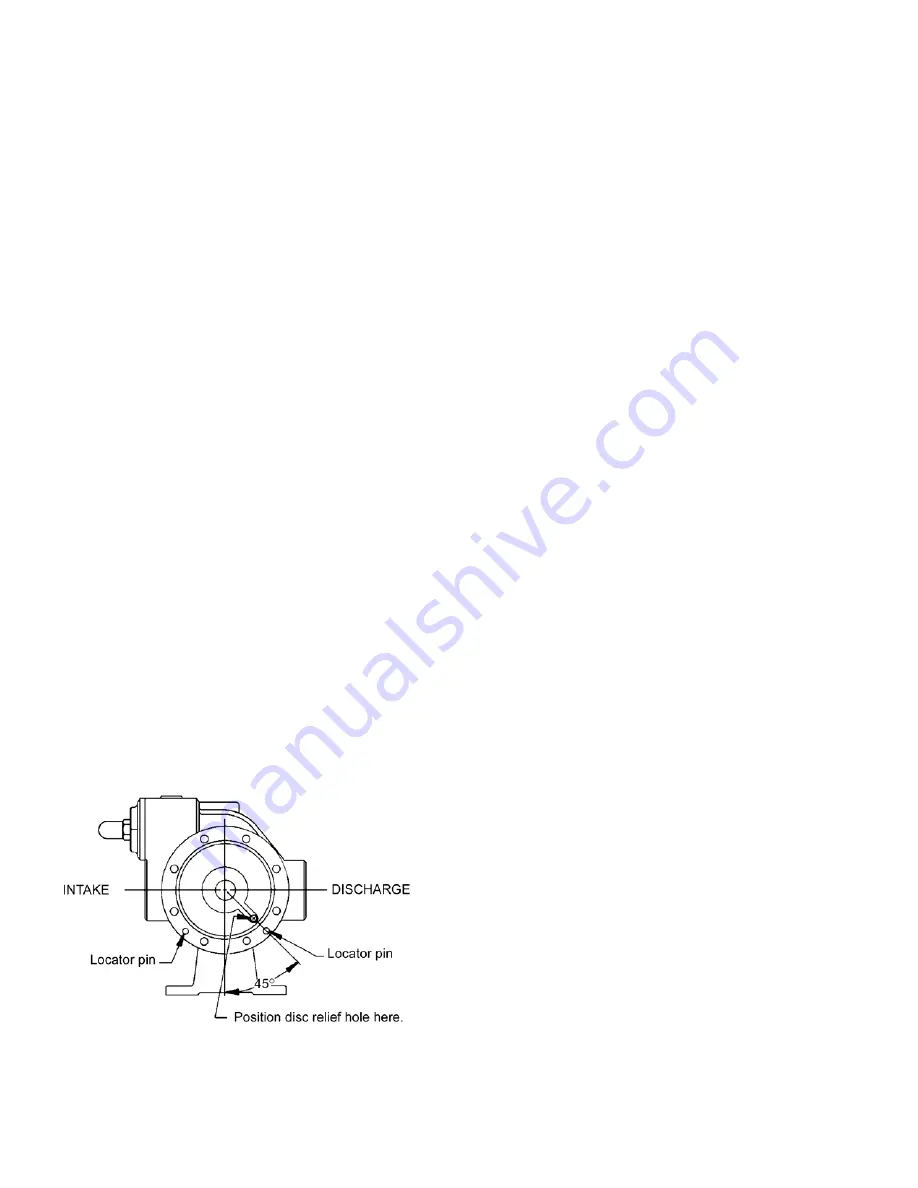
105-A00 Page 8/12
MAINTENANCE
PUMP ASSEMBLY
Before reassembling the pump, inspect all component
parts for wear or damage, and replace as required.
Wash out the bearing/seal recess of the head and
remove any burrs or nicks from the rotor and shaft.
Remove any burrs from the liner.
Reassemble the OUTBOARD side of the pump first:
1. Align the liner keyway with the setscrew (74) that
extends down into the pump casing (12) and start the
liner (41) into the casing. The word “INTAKE” cast on
the liner must face the intake port of the pump casing.
Uniformly tap the outer edge of the liner with a rubber
mallet to fully insert into the casing.
2. Place the disc (71) against the liner (41) with the seal
cavity outward and disc relief hole located as shown in
Figure 6.
3.
Without installing the head O-ring (72) or mechanical
seal components, temporarily attach the outboard head
(20) and bearing (24) to the casing (12). Install and
hand-tighten two head capscrews (21), 180 degrees
apart. This head will be used to hold and align the rotor
and shaft (13) while the inboard side of the pump is
assembled.
NOTE: It is a good practice to attach
pump heads to the same ends they were removed
from.
4. Before installing the rotor & shaft assembly (13), the
direction of pump rotation must be determined as
follows: If the pump is to be
right-hand
with
clockwise
rotation, the intake port and the relief valve must be on
the
right
with the drive end of the shaft pointing towards
the observer. If the pump is to be
left-hand
with
counterclockwise
rotation, the intake port and the relief
valve must be on the
left
with the drive end of the shaft
pointing towards the observer.
5. Remove the vanes (14) and push rods (77) (if equipped)
from the rotor and shaft assembly (13). Inspect for wear
and damage, and replace as follows:
a. Insert the vanes (14) into the bottom rotor slots with
the relief grooves facing in the direction of pump
rotation, and with the rounded edges outward. See
Figure 5.
Figure 6 - Disc Relief Hole Location
b. If the pump is equipped with the four-vane rotor and
shaft (13A), hold the two bottom vanes (14) in place
while inserting the two push rods (77).
c. After the bottom vanes (14) (and push rods, (77) if
equipped) are installed, carefully insert the non-driven
end of rotor and shaft into the casing (12).
d. Install all remaining vanes (14) into the top positions of
the rotor.
6. Install the disc (71) on the inboard side of the pump with the
seal cavity facing outward and the disc relief hole located
as shown in Figure 6.
7. Install a new head O-ring (72) in the groove between the
disc (71) and the casing(12).
8. MECHANICAL SEAL INSTALLATION
Rotating Assembly –
a. Apply a small amount of motor oil on the shaft between
the shaft threads and the rotor.
b. Slide the seal jacket assembly (153C) over the shaft
and into the disc cavity with the drive tangs of the jacket
towards the rotor. Rotate the jacket assembly to
engage the drive tangs in the rotor slots.
c. Install a new rotating O-ring (153E) in the rotating seal
face (153B). Align and insert the rotating assembly into
the the seal jacket with the polished face outward.
Clean the polished face with a clean tissue and alcohol.
Stationary Seat –
d. Apply a small amount of motor oil in the seal recess of
the head (20).
e. Install a new stationary O-ring (153D) in the stationary
seat (153A). Clean the polished face with a clean
tissue and alcohol. Align the pin in the stationary seat
with the slot in the head recess and push the seat fully
into the seal recess with the polished face outward.
9.
Carefully install the inboard head assembly (20) over the
shaft. Do not contact the end of the shaft with the polished
face of the stationary seat. Center the head on the pump
casing (12). Install and uniformly tighten four head
capscrews (21) 90° apart,; torque to 15 lbs ft (20.3 Nm).
NOTE: It is a good practice to attach pump heads to
the same ends they were removed from.
10. Hand pack the ball bearing (24) with grease. Refer to the
"Lubrication" section for the recommended grease.
11. Install the bearing (24) into the head recess. The bearing
balls should face outward, with the grease shield inward.
The bearing must be fully and squarely seated in the head
(20).
12. Turn the pump casing around and remove the outboard
head (20) previously installed.
13. Install the outboard head (20), mechanical seal (153) and
bearing (24) as instructed in steps 6 through 11.
14. Rotate the shaft by hand to engage the mechanical seal
drive tangs, and to test for binding or tight spots. If the
rotor does not turn freely, lightly tap the rims of the heads
(20) with a soft faced mallet until the correct position is
found. Install all of the remaining head capscrews (21) for
each head and uniformly torque to 15 lbs ft (20.3 Nm).
Summary of Contents for XLW1 1/2
Page 11: ...105 A00 Page 11 12 NOTES...






























